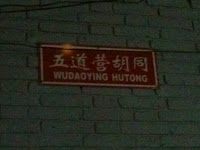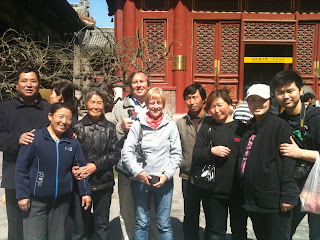Fated Hutongs and Growing Markets: Chocolate and Other News in Beijing

Everyone and everything seemed to converge at Wudaoying Hutong when I was in Beijing last weekend. I was being a tourist with Pitt MAP leader Dave Bartholomae and his wife Joyce on Sunday afternoon, and my Beijing's Best ap indicated that, from our location at the Lama Temple, we were .3 kilometers from Brand Nu, a boutique that strives to introduce rural craftspeople to urban consumers and to introduce urban designs and profits to the same rural artisans. But the ap's map was malfunctioning, either because Google and my Chinese iPhone carrier weren't cooperating or because the application's creative and technical aims were out of sync (as I talked about with the Pitt MAP students in class the next day, all writing is a struggle to fit particular material into the particular form you've chosen for it). Without specific coordinates, we decided to just wander into the lane, or hutong, across the street from the temple to see what we would find. According to Dave, whose sources include the dog-eared guidebook he carries around with him and Michael Meyer's book The Last Days of Old Beijing, the hutongs are networks of tiny housing units that, by winding in on themselves and away from the outside world, created durable communities, first among extended families, then, after the revolution in 1949, groups of workers, and now, after the economic reforms that began in 1978 and have been reinforced in every five-year plan since then, among artists, entrepreneurs, and middle-class consumers. Familiarly lost, we looked around for friendly souls and then approached them in English. Did they know how to find Wudaoying Hutong?, we asked. Wudaoying Hutong? We were standing on it. We wandered around, comparing this renovated, refitted version of a hutong to the neighboring alleys where a whole family might still share a single room without a bathroom to the cement-dust-covered construction sites in the process of changing from the old style to the new. A few minutes later, Pitt MAP's global health professor Peter Veldkamp, who had been circling Beijing's ring roads on his bicycle, called to find out where we were. Wudaoying Hutong, we told him. Wudaiying Hutong?, he asked. He too was on Wudaoying Hutong.

 And after a trip to the iStore-flashing Sanlitun mall, a quiet drink among photos of Mongolian cowboys at the Amilal Whisky Bar, a writing class, and a day of classic Beijing cuisine (street-side noodle vendors and table-side roast duck carvers), I asked some of the Pitt students to join me at a Grave Sweeping Day folk and blues show (not quite the same thing as catching Bob Dylan's China tour, but an exchange of cultural fluids nonetheless). The only thing was we had to find the place. Where was it? Wudaoying Hutong.
And after a trip to the iStore-flashing Sanlitun mall, a quiet drink among photos of Mongolian cowboys at the Amilal Whisky Bar, a writing class, and a day of classic Beijing cuisine (street-side noodle vendors and table-side roast duck carvers), I asked some of the Pitt students to join me at a Grave Sweeping Day folk and blues show (not quite the same thing as catching Bob Dylan's China tour, but an exchange of cultural fluids nonetheless). The only thing was we had to find the place. Where was it? Wudaoying Hutong.Inspired by econ professor Svitlana Maksymenko's sweet tooth, my hosts and I decided to spend the grave-sweeping holiday (a variation on Day of the Dead) seeking out chocolate in China's capital. "The first thing to hit your tongue is the sort of bitterness of this powder," Dave soon declared about the hand-rolled truffles prepared by Laurier Dubeau at La Place Collection, a not-quite-retail store in an office tower (which I discovered on the Chocomap). "But then it's great. It's smooth and creamy. Chocolatey. It's real dark chocolate but without bitterness." La Place's hazelnut truffles, with a core of Belgian Belcolade milk chocolate, taste like finer, fresher Ferrero Rochers; and the dark chocolate variety is unadulterated French Valrhona, the brand I named at dinner when asked what my favorite chocolate was. La Place--just like, as far as I can tell, all of their competitors in Beijing and elsewhere in China--is a chocolatier rather than a chocolate-maker. This means that they don't make chocolate but they use chocolate to make confections. Again, there's nothing wrong with this. Nobody berates the baker for not milling his own flour. But there are a couple of connections I would like to make. Something I've said before but will repeat here is that chocolate is a commodity produced in the developing world and refined and consumed in the developed world. But is China the developing world or the developed--or do we need a new global-power vocabulary? And I will be very curious to see how China, one of the major forces of development in 21st-century Africa (the continent where the vast majority of the world's cacao beans are harvested), will change cacao agriculture, chocolate production, and global views on ethical chocolate trading in the coming years.
Our next stop was one of the several branches of Les Comptoirs de France, recommended by Elyse Ribbons, coordinator of the monthly Chocojing meetings. The menu promises and makes good on several wholesome hot chocolates and the shop we visited dolls up the sidewalk with welcome outdoor seating. But I'd describe Les Comptoirs as a second-rate facsimile of Payard Patisserie in New York: inside the fancy packaging, tart shells are cracked and bonbons are unevenly dribbled with chocolate. Something to point out, though, is that Payard closed down last year and Beijing's Comptoirs are going strong with five locations. Svitlana (a native of the Ukraine who explained that "I'm happy for China--China has done what the Soviet Union wanted but never got a chance to do") attributed the success to two very simple factors: an enormous population and a strong economy. So the market for everything is growing? I asked, taking advantage of our taxicab conversation to make up for the economics class I never took in college. "No," she said. "The market for audio tapes is not growing." A budding Beijing chocolatier named Emay Wang, coincidentally, posted thoughts on the same topic on the Chocolate Life a couple of weeks ago.
To be among other travelers in Beijing in April of 2011 is a poignant experience. We are foreigners to the place, don't know its rhythms or its routines. Yet we're more likely to find extensive, inquisitive reporting of the news at home than locally. The best response, I think, is for us, any of us, from anywhere, to learn as much as we can and come to our own conclusions.










1 Comments:
Great article thanks from Choc-affair in the UK!
Post a Comment
<< Home